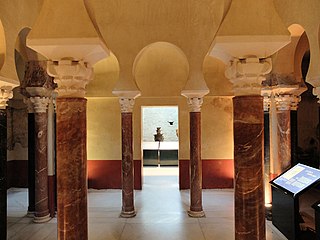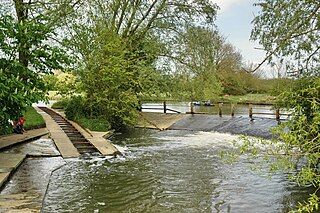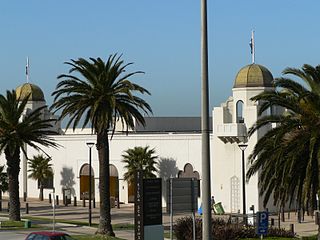 W
WThe Arab Baths in Ceuta are medium size medieval public baths on the northern edges of the Medina quarter. This is thought to have been occupied since the 11th century. Archaeological investigations in 2000 and 2004 have shown that the baths had one room for clothes and toilets followed by a cold bath and then a hot bath in a style laid down by the Romans. Other rooms may have existed.
 W
WThe Arab Baths of Jaén are a well-preserved historic hammam located in Jaén, Spain. The bathhouse dates from the 11th century during the Taifa or late Caliphal period, but may have undergone later alterations, probably in the 12th century. It is one of the largest known examples of Andalusi bathhouses, and is distinguished from others by its particularly large "warm room".
 W
WThe Baños de Tenerías were a public bath in Toledo, Castile-La Mancha. The structure has been dated to the beginning of the 11th century, when Toledo was under Islamic rule, and formed one of the six Arab baths in the city.
 W
WThe Beitou Hot Spring Museum is a museum about hot spring in Beitou Park, Beitou District, Taipei, Taiwan.
 W
WBimini Baths was a geothermal mineral water public bathhouse and plunge in what is now Koreatown, Los Angeles, California, US. It was situated just west of downtown, near Third Street and Vermont Avenue. Bimini Baths contained a natatorium, swimming pools, swimming plunge, Turkish baths, a medical treatment department, and bottling works.
 W
WThe Caliphal Baths are an Islamic bathhouse complex in Córdoba, Spain. They are situated in the historic centre which was declared a World Heritage Site by UNESCO in 1994. The complex was contiguous to the former Caliphal Palaces of the Umayyads, whose inhabitants it served. Today the baths have been partially reconstructed and are open as a museum.
 W
WDivision Street Russian and Turkish Baths / Red Square is a traditional Russian-style bathhouse at 1914 W. Division Street in the Wicker Park neighborhood of Chicago, Illinois, which closed in 2010 and reopened in 2011 under the name Red Square, offering separate facilities for both men and women, with some mixed gender areas as well. It has operated since 1906.
 W
WThe Bañuelo or El Bañuelo, also known as the Baño del Nogal or Hammam al-Yawza, is a preserved historic hammam in Granada, Spain. It is located in the Albaicin quarter of the city, on the banks of the Darro River. It was used as a bathhouse up until the 16th century at least, before becoming defunct and being converted to other uses. In the 20th century it underwent numerous restorations by Spanish experts and is now open as a tourist attraction.
 W
WThe Finnish Sauna is a former public bath in Virginia, Minnesota, United States. It opened around 1912 to cater to urban Finnish Americans who wished to maintain the Finnish sauna tradition. It was listed on the National Register of Historic Places in 1980 for its local significance in the themes of architecture and social history. It was nominated for representing the strong influence of Finnish American culture on the Iron Range, and the commercial services developed to perpetuate it.
 W
WThe Greek Baths of Gela are ancient baths which were discovered in 1957, near the Ospizio di Mendicità on via Europa, Capo Soprano, which date to the Hellenistic period. Like the rest of the city, the baths were demolished in 282 BC after the conquest of the city by the Akragantine tyrant Phintias.
 W
WHaggerston Baths in Hackney, London, was opened in 1904 as public baths. The baths were built at a cost of £60,000. There was a single pool, 91 slipper baths and a 60 stall wash house.
 W
WThe James Lick Baths in the South of Market District of San Francisco, California. It is a San Francisco Designated Landmark. It combined aspects of public bathing and self-service laundry.
 W
WMedina House is a former Turkish bath on the seafront of Hove, Sussex, England. After falling into disuse it was squatted for several years. During this period Sirus Taghan, the then owner, agreed that the occupants could remain, so long as the property was kept in the same condition as before occupation. It was finally evicted in September 2006, although it was re-occupied for a week at the end of January 2007.
 W
WParson's Pleasure in the University Parks at Oxford, England, was a secluded area for male-only nude bathing on the River Cherwell. It was located next to the path on the way to Mesopotamia at the south-east corner of the Parks. The facility closed in 1991 and the area now forms part of the Parks.
 W
WThe Plant Bath is a historical bath in Ottawa, Ontario, Canada. It was built along with the Champagne Bath in 1924 to try to improve the hygiene and well-being of the city's lower classes. It was named after Frank H. Plant, then mayor of Ottawa. It is located at 930 Somerset Street West at the intersection with Preston Street. It is in the centre of the Italian-Canadian community and near the Chinese-Canadian areas of the city.
 W
WRamsden Hall located at 48 Abbey Road in Barrow-in-Furness, Cumbria, England is a Grade II listed former public bath house. Funded by industrialist and local mayor Sir James Ramsden it was constructed in 1872 and was relatively small in comparison to other public baths in Barrow. Despite no longer serving its original purpose Ramsden Hall stands as the only remaining example of a 19th-century public bath in the town. For a period of its history, the building served as an annexe of the adjacent Technical School although at present it is occupied by offices of the Citizens Advice Bureau.
 W
WThe Rotorua Museum Te Whare Taonga o Te Arawa is a local museum and art gallery in the Government Gardens near the centre of Rotorua, Bay of Plenty, North Island, New Zealand.
 W
WThe St Kilda Sea Baths is a pool, spa, food and entertainment complex on St Kilda Beach, Victoria, Australia. Numerous 'seabath' structures have come and gone on the St Kilda foreshore, the last built in a Spanish- Moorish style in 1931, which was demolished in the 1990s and replaced by the present structure, partly reconstructing the 1931 baths.
 W
WThe Simmons Island Beach House is located in Simmons Island Park in Kenosha, Wisconsin. It was added to the National Register of Historic Places in 2003.
 W
WThe Central Mineral Baths is a landmark in the city center of Sofia, the capital of Bulgaria, a city known for the mineral springs in the area. It was built in the early 20th century near the former Turkish bath and was used as the city's public baths until 1986.
 W
WThe Sutro Baths was a large, privately owned public saltwater swimming pool complex in the Lands End area of the Outer Richmond District in western San Francisco, California.
 W
WThe Svetlin Rusev Donative Exhibition is a permanent art exhibition in Pleven, Bulgaria, including over 400 works of Bulgarian and foreign art donated by the noted Bulgarian artist and collector Svetlin Rusev.